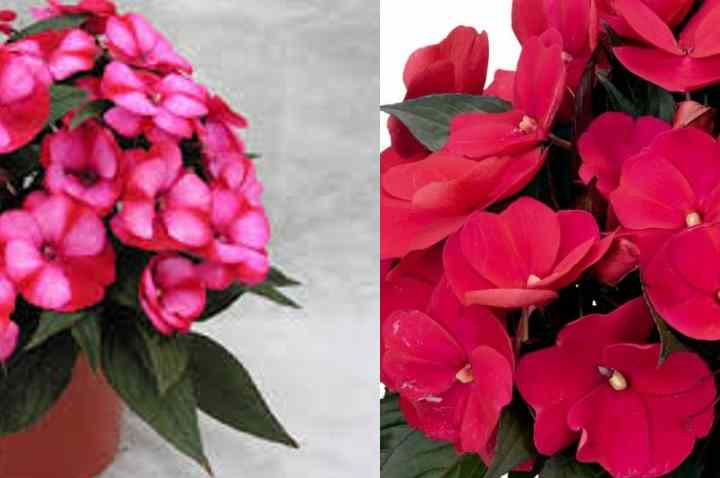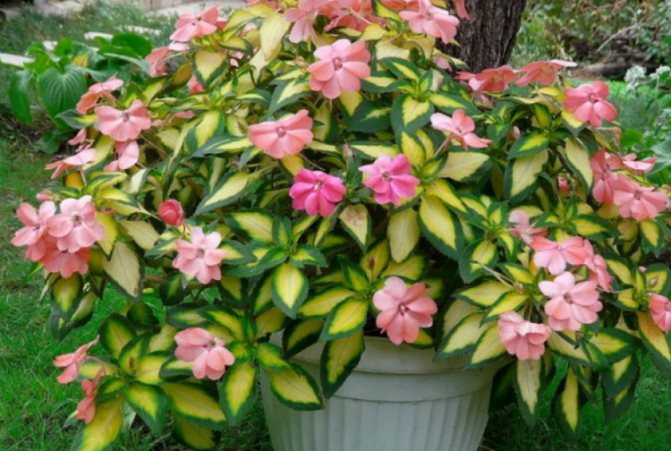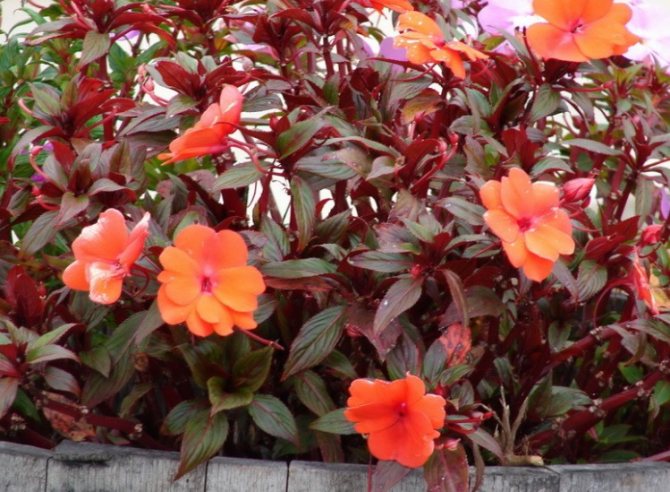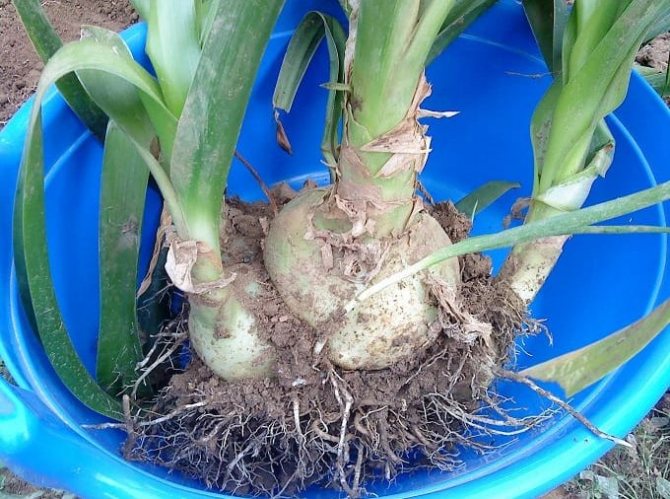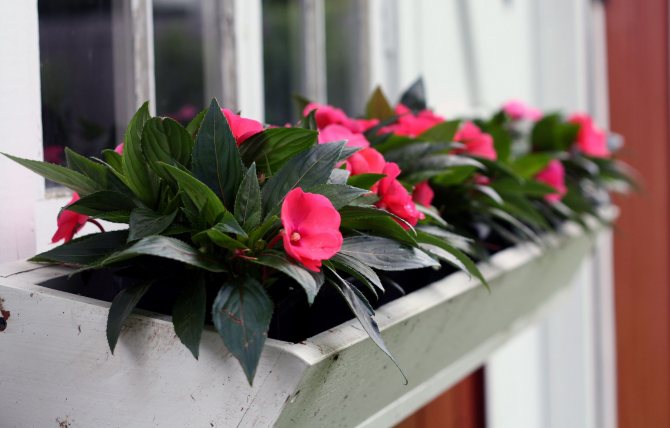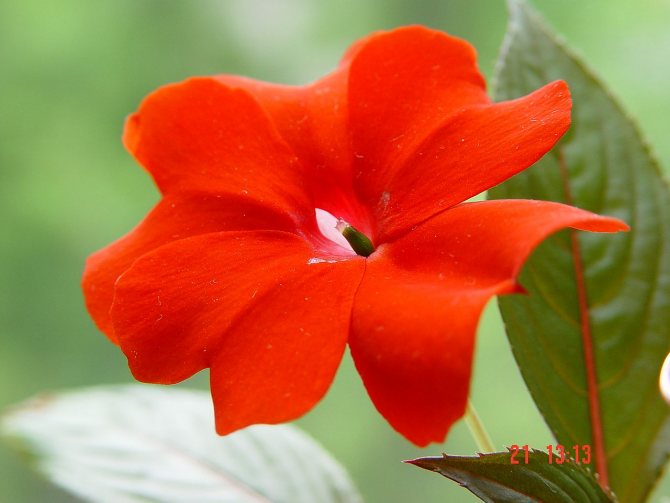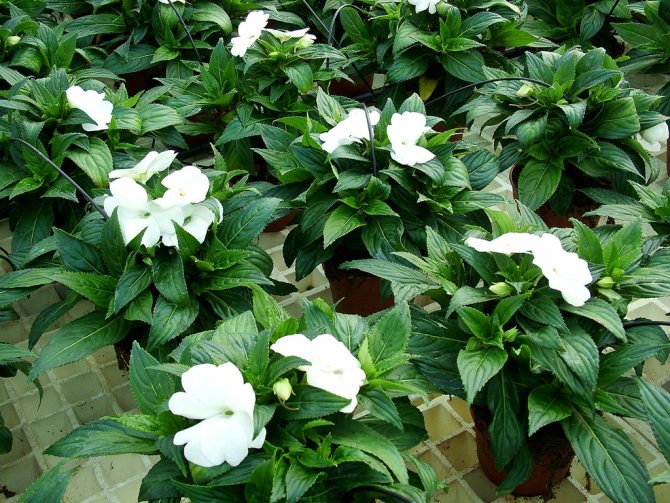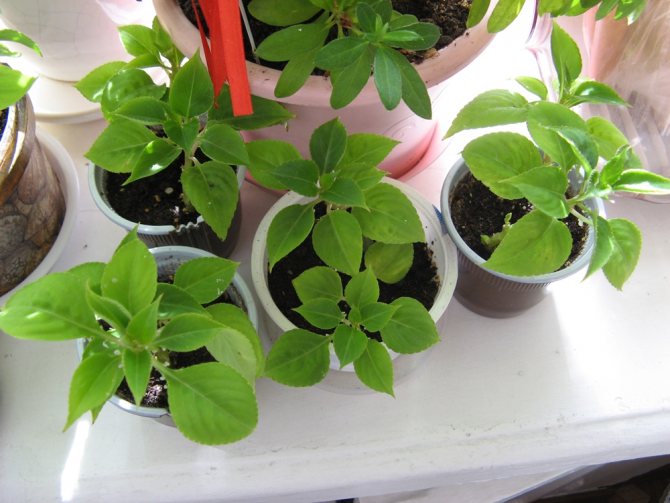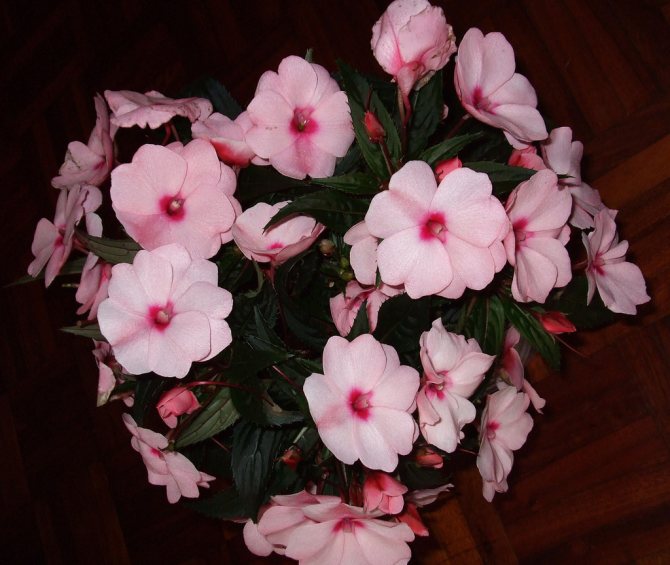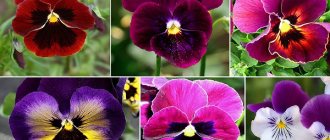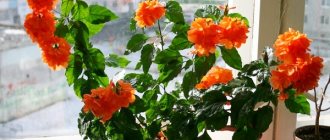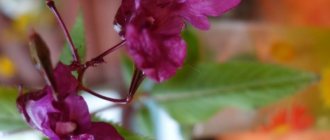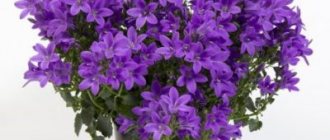Description and characteristics
Vanka Wet belongs to the Balsamin family, which consists of two genera - Hydrocera and Balsamin (or Impatiens). The genus Hydrocera has only one species of the same name, representatives of which live in swamps. The genus Impatiens is numerous, it includes 500 species of plants. Some of them are used in floriculture.
Plants from the Balsamic family live throughout the earth. Most Impatiens prefer the humid tropics of Africa and Indochina. In the temperate continental climate of Russia, you can find 8 varieties, among them - Forest balsam, which has long been used as a medicine.
A whole group called Waller's (Waller) balsam is cultivated as an indoor flower. These are perennials with lush, but compact, highly branched bushes, 15-40 centimeters high, with shiny, greenish or cherry-bronze leaves and scarlet, purple, snow-white, pinkish or variegated flowers.
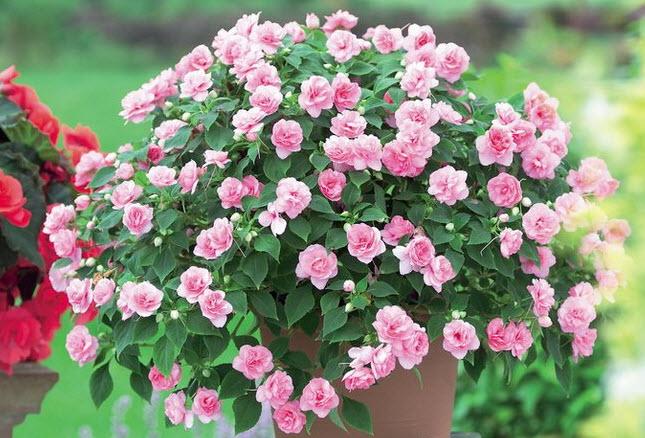
There are flowers single or collected in inflorescences, simple or double, in shape - pink, camellia, clove. Touch-me-not looks like a lush bouquet with flowers growing at the top. It blooms for a long time, from April to December. After pollination in the fall, seeds ripen in a small, but very sensitive to touch, capsule.
In addition to indoor balsam, garden balsam is grown, which is called - Impatient Balsamic.
Sadovy is an annual culture with a pyramidal or highly branched, almost spherical, stem, 40-70 centimeters high. Blooms profusely throughout the summer (May to October). The stems are juicy, as if saturated with moisture, translucent. Leaves are petiolate, small, lanceolate, pointed upwards, arranged in the next order. Flowers - large, irregular, can have all sorts of colors - from pale pink to deep burgundy.
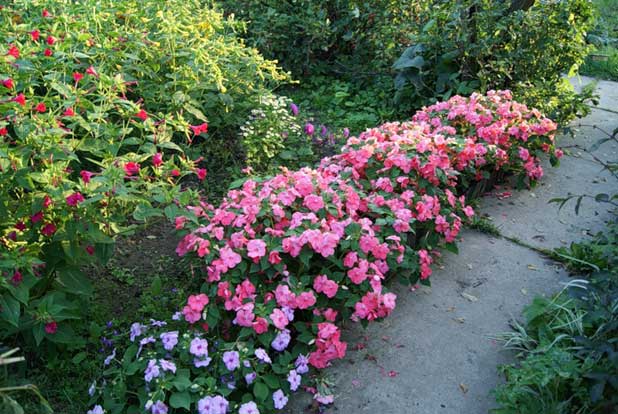

In Russia, the balsam was nicknamed Vanka Wet for a reason. The plant loves water. It does not tolerate drought at all. In case of a lack of moisture, it instantly withers, the leaves wrinkle, the flowers droop.
Balsam is also called Wet for the reason that a sugary liquid appears at the edges of the leaves of the plant. This protective property of balsam protects flowers from attacks by ants and aphids. The pollen and flower nectar remain for the bees, which also pollinate the flowers.
Monastic Sugar is another name that the plant got thanks to sweet dew drops. Impatiens often release a sugary liquid after abundant watering. Bright red flowers resemble lights. The people called the balsam the Fire. In European countries, the plant is called Diligent (Diligent) Lisa, as it blooms tirelessly from April to November.
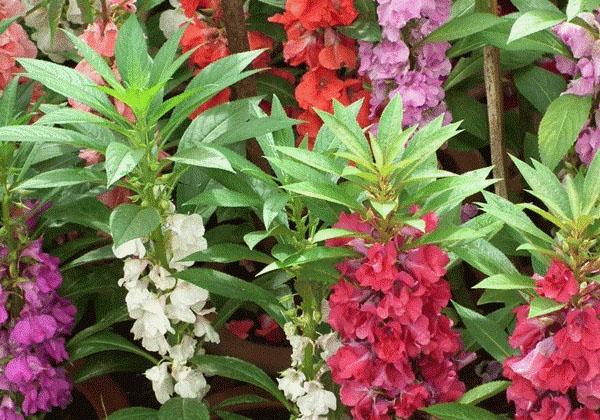

The touchy balsam was named for the method of spreading seeds. When a ripe fruit is touched, it opens with a bang, the shutters quickly twist into spirals, and the seeds fly up to 2 meters. Vanka Wet has very brittle shoots. This is one of the plant propagation methods. Broken off cuttings can be put into water, and later planted.
Description
An adult plant reaches a height of 20 to 60 cm. The stem is light green, translucent.There are both upright and ampelous plants. The leaves are large, from 8 to 12 cm. Oval in shape with denticles at the edges. The plant blooms from May to December. Roly flowers are located on flat corollas. They reach 4 cm in diameter.
Vanka belongs to the genus Balsam, in the list of which there are about 400 species of plants. Lovers of flower growers mainly grow indoors such types of balsam as:
- Holst.
- Waller.
- Sultansky.
- New Guinea hybrids.
Flowers with a varied palette of shades give the plant a special charm. They can be from light pink to dark red colors. You can also often find balsams, the petals of which are painted in several colors.
Modern breeders are constantly working on the development of new varieties of the plant. So, in recent years, many large-sized flowers have appeared. Moreover, the bushes remain small, which makes it possible to grow them on windowsills.


Also popular are plant varieties with double flowers. Loggias and rooms decorated with such hybrids look great. This houseplant, thanks to its many bright flowers, looks very beautiful and decorative, as shown in the photo.
Continuing to work on the development of new varieties, the breeders went even further: they created a plant with variegated leaves. Such a wet flower Vanka attracts people's eyes even when its buds have not yet opened.
Views
There are over 500 types of balsams. Plants vary in height, color and flower shape. Indoor and garden balsams are divided into 3 groups.
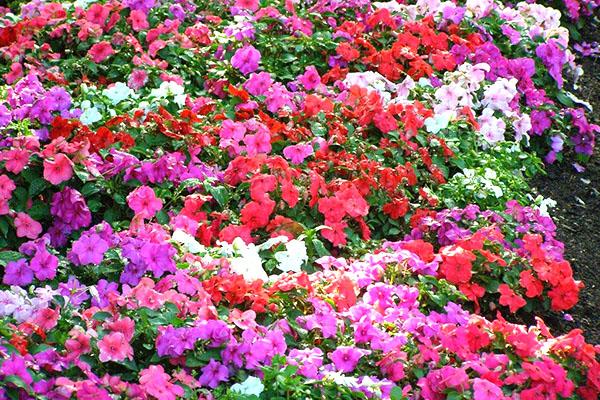

Touchy groups:
- First.
This group includes traditional varieties of Waller's balsam. They are grown in pots, greenhouses or garden beds. This species is represented by various varieties and interesting hybrids. Flowers are simple or double, snow-white, pinkish, purple, reddish.
- Second.
This group includes heterotic hybrids (F1). They appeared as a result of breeding work with the Impatient Waller. Hybrid varieties are represented by perennial compact bushes that bloom profusely for almost a whole year.
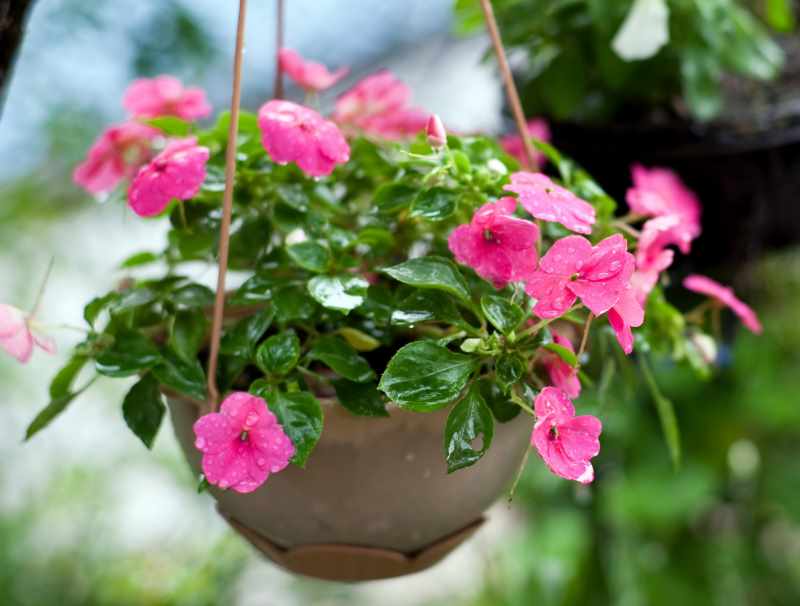

- Third.
This group includes balsams from New Guinea. New Guinea hybrids were obtained from the crossing of Hawker's balsam, linear-leaved, Schleiger. These plants can be found in the forests of New Guinea. New Guinea hybrids have fleshy leaves, a strong stem, large flowers, a more compact appearance. They are mainly used in indoor floriculture.
To size
Balsams can have different stem heights. Low-growing hybrids are usually planted in indoor pots, and with the help of tall plants they usually decorate city flower beds and garden plots.


Dwarf
This group includes balsams up to 26 centimeters high. Small dwarf bushes of perennial plants are grown in indoor pots. They differ in color and flower shape. These include the various varieties of Balzamin Waller. Low-growing annuals are often planted in garden plots and city flower beds.
Medium-sized
Medium-sized plants include plants reaching 26 to 41 centimeters in height. These are compact branched bushes with green leaves and flowers of various colors and shapes. This group includes garden balsam, New Guinea hybrids.
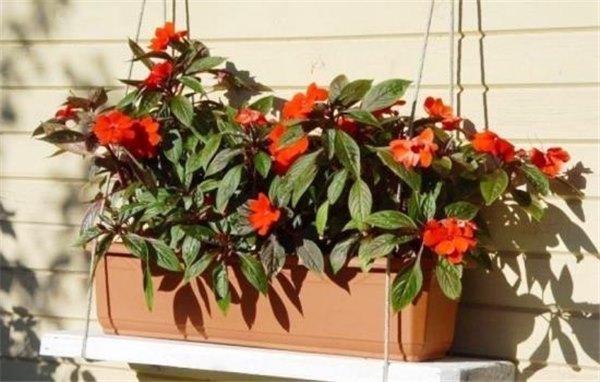

Tall
Impatiens, whose height is 75 centimeters and above, belong to the tall group. Most often, these plants are planted as a hedge or border flower. The plant has a pyramidal or spherical shape. The stems are juicy, fleshy, the leaves are lanceolate, growing in the next order. The plant is abundantly decorated with large flowers of various shades of red.
By form
The main advantage of balsams is flowers. There can be up to 50 of them on one plant. According to the doubleness, the flowers are divided into camellia, pink and clove.


Camelliaceae
Large double flowers look like a camellia. There are pale pink, reddish, white, lilac shades.
Carnation
The flowers are reminiscent of the Dutch double carnation. The petals have fringed or scalloped edges. They can be pale pink, reddish, lilac or variegated.
Rosy
Densely double flowers resemble tiny roses. The petals are wrapped in a spiral. Flowers can be monochromatic or bicolor.
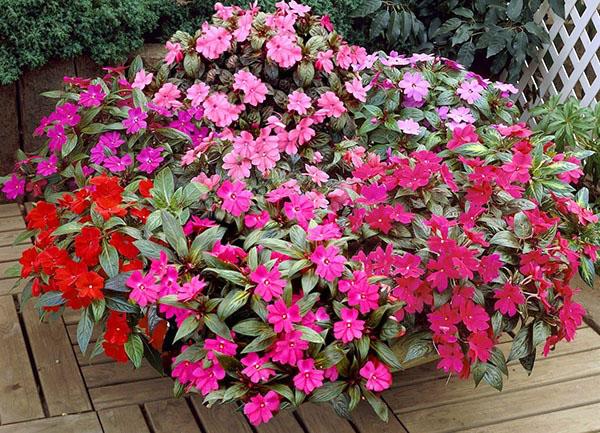

Flowering features
Balsam room - home care
Continuous year-round flowering is exactly what attracts indoor flower lovers. It is this quality that distinguishes the New Guinea variety from other balsams. In winter, the plant continues to grow and bloom, rather than falling into a dormant state.
The shape of flowers in different varieties is almost identical - they consist of several rounded petals, which converge at the base to the core. The color depends on the variety and can be either one-color or two-color.


In summer, you can take out the pot or plant it in the ground
Popular varieties of balsam
Many varieties of Nedotrog are bred on the basis of Waller's balsam, garden or New Guinea. They differ in color, size and shape of flowers, as well as the height of the bush.
Garden Tom Tamb
This short balsam bush (25 centimeters) is planted in city flower beds and garden plots. The plant has oblong lanceolate leaves, double flowers of various shades (pink, scarlet, purple, snow-white). Tom Tamb is a one-year-old blooming all summer long.
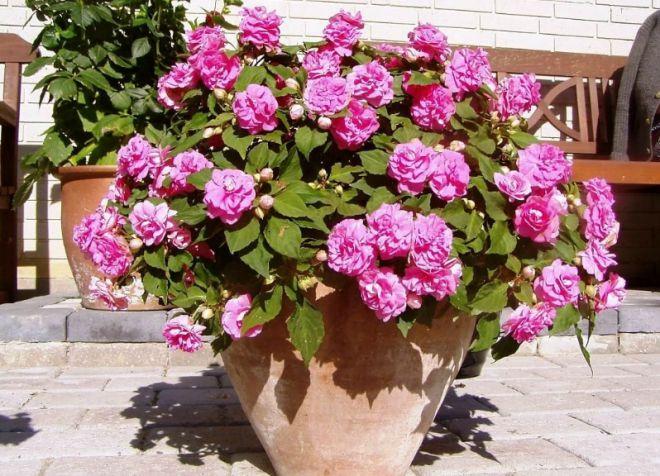

Camellia
Tall and vigorously branching plant. It can stretch up to 61 centimeters in height. The Camellia variety blooms for a long time and abundantly. Flowers - double, pale pink or purple. An annual used for flower bed decoration.
Waller
The touch-me-not Waller is a popular indoor and garden culture. Height - 26-40 centimeters. The bush has a spherical shape, juicy, highly branching stems. Flowers can be simple and double, of various colors. Impatiens blooms for almost 90 days. The variety is often used to breed new hybrids.
Exotic dwarf
A small plant often used to decorate balconies. The height of Impatiens is only 20 centimeters. Leaves are lanceolate, serrate. Flowers can be purple, pink, bright red.
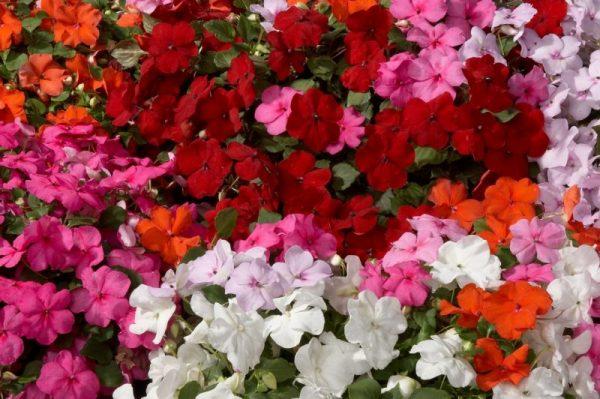

Harmony
A beautiful, compact plant obtained on the basis of New Guinea balsam. Forms a lush bush, strewn with large round flowers on top. This thermophilic plant is usually grown in indoor pots.
Java
Long blooming Impatiens, bred on the basis of New Guinea balsam. This plant has bright, exotic-looking flowers blooming against the backdrop of shiny greenish or bronze leaves.


Mini jini
A series related to New Guinea hybrids. Balsam has small dark green leaves and numerous small flowers that cover the bush almost all year round.
Macarena
Balsam from the group of New Guinea hybrids. Impatiens have bright, luminescent, orange flowers and bronze-green leaves.
Camelia flowered
Tall plant. The variety is bred on the basis of garden balsam. It has a high pyramidal stem, oblong leaves, pink or lilac flowers.


Peppermmint
Erect pyramidal plant, 40-45 centimeters high. Flowers - camellia-like, large, double, can be scarlet, pink, monochromatic or white speckled. The annual blooms in gardens from June to September.
Baby bush
Low-growing garden plant. One-year-old, reaching 25 centimeters in height. Blooms for a long time with large pink-like flowers.
Tom thumb
Dwarf garden variety. One-year-old blooming all summer long. Flowers - terry, can have snow-white, pink, scarlet, lilac color.


Scarlett
Garden culture, 26-40 centimeters high. Abundantly covered with flowers from June to September. The color of the petals is bright red.
Sultanoid
Indoor culture with a height of 31-61 centimeters. Leaves are green with serrated edges. The flowers are similar in shape to an orchid, are located one by one on a long stem, have a spur, are white, reddish, pale pink. In an apartment, Impatiens can bloom throughout the year, flowers replace each other, each bloom for about 2 weeks.
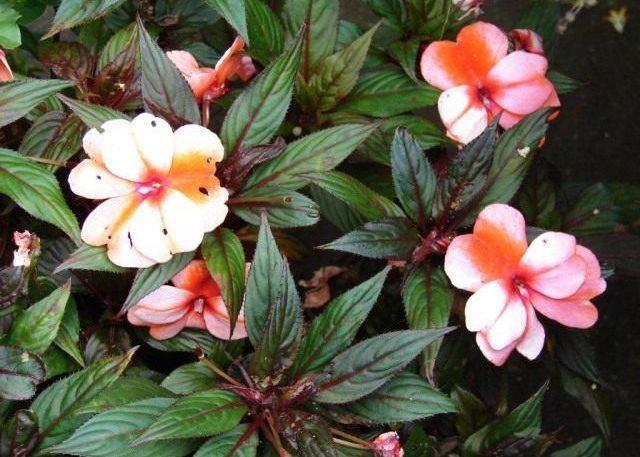

New guinea
It is more often grown as an indoor perennial. The plant is tall but compact. Grows up to 30-45 centimeters in height. It is characterized by abundant and long flowering. Requires long daylight hours and high temperatures. It has large double flowers, mostly pinkish and scarlet.
Terry
Indoor culture with dark green shiny leaves and large double flowers. Touch-me-not blooms almost all year round. Flower petals can be pink, scarlet, snow-white, solid or variegated.
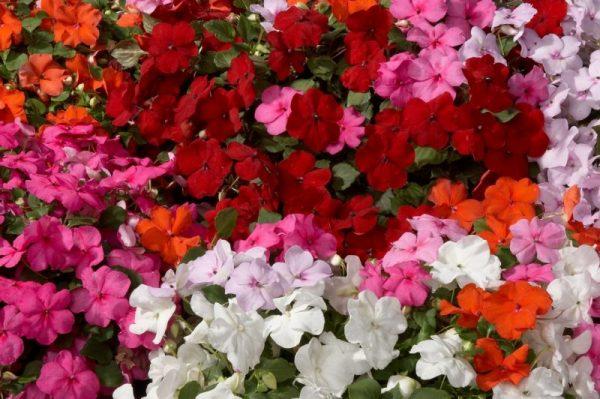

Popular varieties
Why balsam does not bloom at home - the main reasons
There are many varieties of New Guinea balsam, but some are particularly decorative. Since the work on selection is very active, not even specific varieties are distinguished, but varietal groups. They have common features, but may differ in color.
- Divaro
Representatives of the variety are distinguished by the compactness of the bush, the rich green color of the leaf plate and the small size of the flowers.
- Macarena
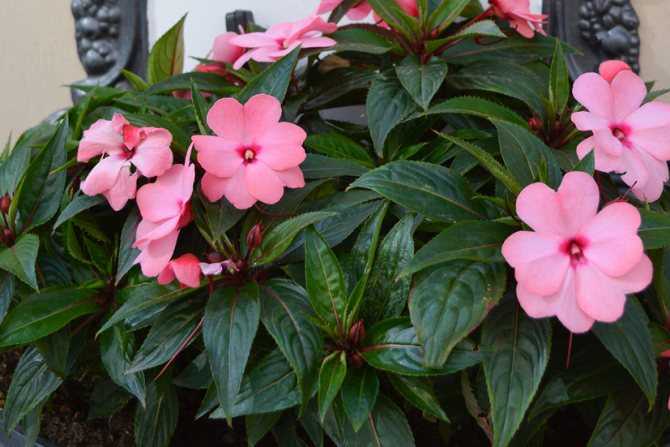

Macarena
A distinctive feature of the variety is an orange or salmon shade of flowers. They look especially decorative against the background of green foliage with a touch of bronze.
- Rainforest exotic
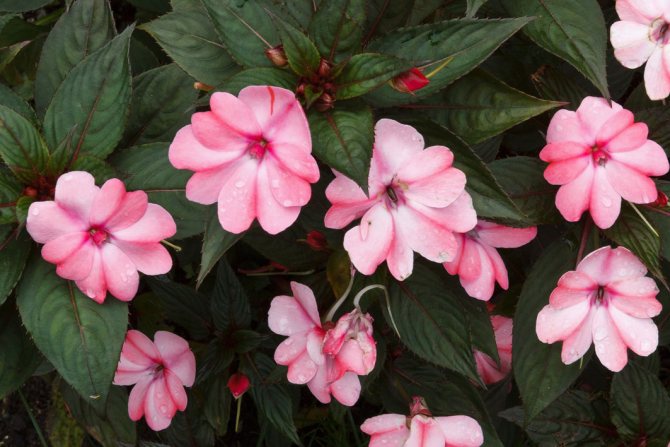

Rainforest exotic
The color of flowers is always bright shades, the foliage is dark green. There are specimens with two-color petals.
- Devine mix
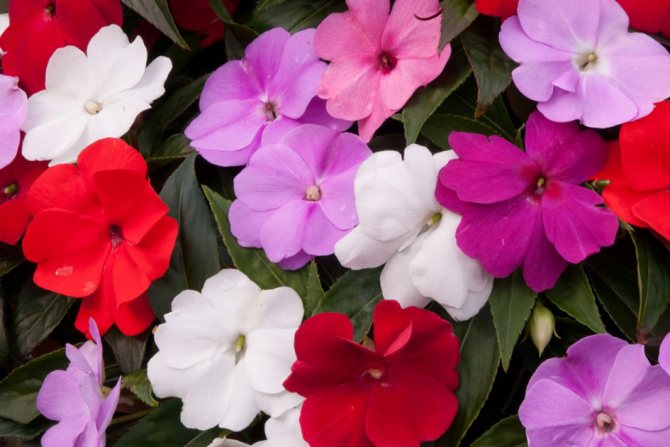

Devine mix
All representatives of the varietal group are distinguished by a compact bush shape. Refers to large-flowered varieties. The petals can be of different colors.
- Jangle rain
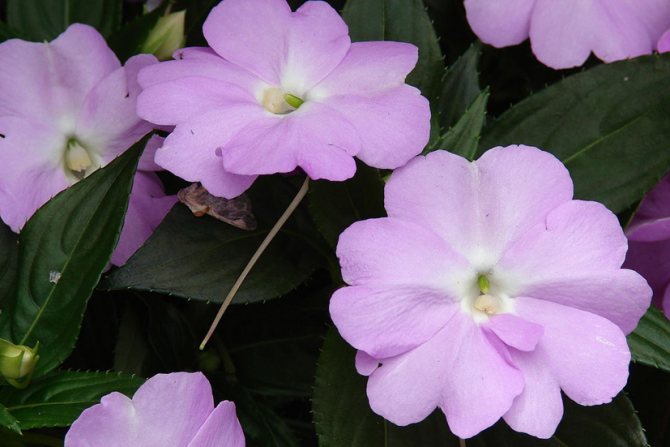

Jangle rain
Only gentle pastel colors are present in the color of the flowers. The leaf plate is glossy, dark green.
Harmony


Harmony
The main feature is the reddish tint of the leaf plate in some varieties. The flowers are round and small in size.
- Mini Gini
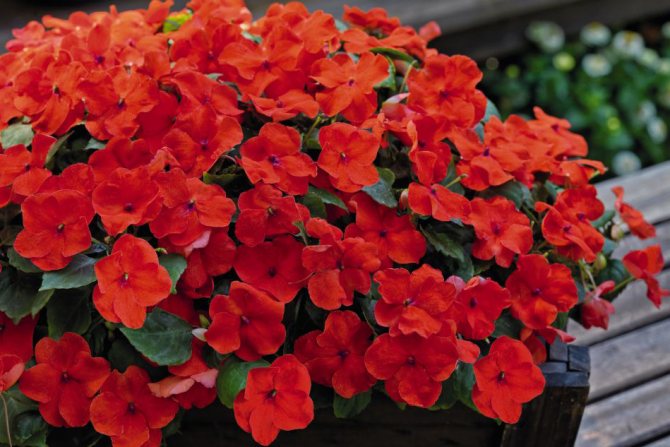

Mini Gini
The small size of the flowers of the variety fully compensates for their number. A compact bush during flowering is almost completely covered with them.
- Spreading White
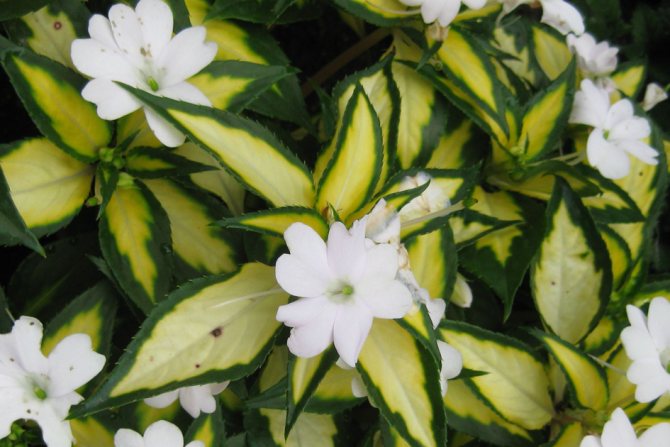

Spreading White
The original variegated variety. The flowers are snow-white in color and have an average petal size.
Growing from seeds at home
You can grow a touchy seed yourself. It is recommended to buy seeds of hybrid plants in specialized stores. These plants are grown in small containers or single containers (plastic cups). For the garden, seeds of annuals are purchased, and for indoor cultivation - perennials.
Sowing
The seeds are preliminarily placed for swelling in warm water for a day. In March, they are sown in containers filled with substrate. The soil should be loosened, without lumps, well moistened. The seeds are sown, and lightly sprinkled with sand on top and irrigated with water. The container is covered with glass or foil.
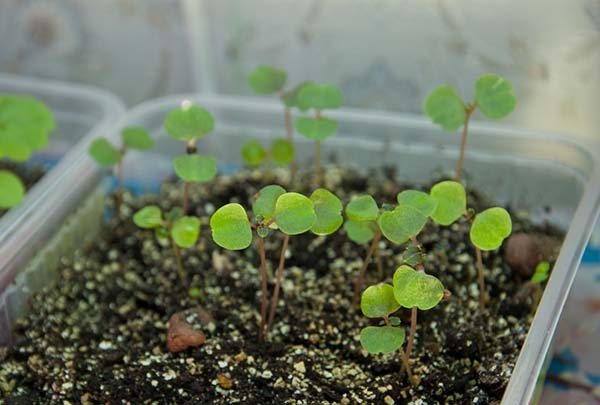

Illumination
Seeds germinate after 1-2 weeks. Seedlings need to be provided with ten hour daylight hours. It is advisable to put containers with growing seedlings on the windowsill, and illuminate with lamps in the dark.
Priming
For Vanka Wet, a neutral and light soil mixture is suitable. Planting substrate can be bought ready-made or made on your own.The land for sowing seeds should consist of garden or leaf land, sand and peat. Seedlings of Impatiens do not like organics. The substrate is pre-disinfected with boiling water or a solution of potassium permanganate. A little perlite is added to the ground, a drainage layer is laid on the bottom of the box.
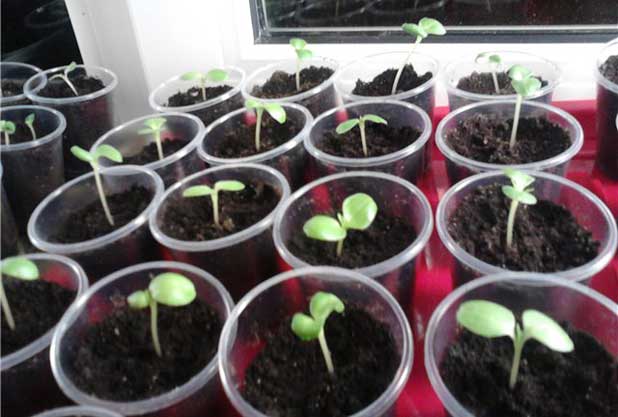

Picking
Developing seedlings need to be irrigated regularly with water. When 2-3 true leaves appear on the seedling, you need to dive. The plants are transplanted individually into peat or plastic cups and the roots are pinched.
Top dressing
At the very beginning, the plants are irrigated with Fitosporin solution, for the prevention of possible diseases. After transplanting into separate containers, the seedlings are fed with a complex fertilizer for indoor flowers (begonias, geraniums, violets) or with Fertika-Lux, Kemira-Lux.
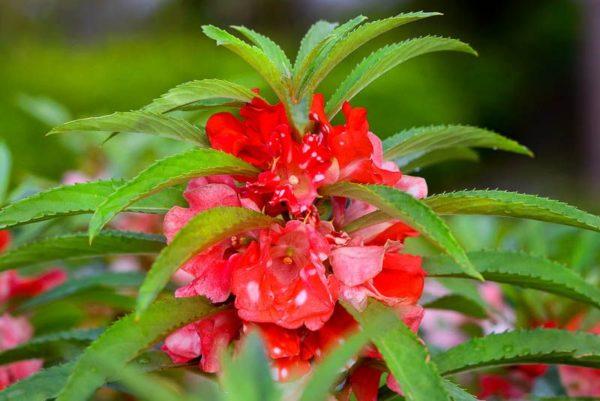

Content temperature
Seedlings should be kept in a warm room. The optimum temperature for development is 20 degrees Celsius. Balsam does not tolerate a temperature drop of up to 10 degrees. Before transferring the seedlings to the flower bed, they need to be hardened. For example, regularly ventilate the room where the plant is located. You can take out pots with seedlings in May daily outside for several hours.
Reproduction and planting


Balsam is propagated mainly by seeds, which can be collected independently from existing bushes or purchased in a specialized store. When buying, you need to pay attention to the expiration date of the seed, as well as information on the antifungal treatment carried out. If such information is not available or the seeds were sold untreated, they should be placed in a weak solution of manganese and left for 10 minutes. After that, the seeds must be transferred to a small strainer and rinsed thoroughly with warm water. The material is now completely ready for sowing.
Early perennial bulbous flowers - garden decoration
Growing from seeds
There are some simple rules for planting New Guinea Balsam. Growing from seeds is done as follows:
- Sow balsam in prepared peat pots or in boxes for seedlings.
- The seeds of the plant are very small, which creates some inconvenience when planting. Therefore, it is recommended to mix them with dry sand, then scatter them over the soil surface and press a little with your fingertips.
- The soil should be lightly irrigated with a spray bottle using room temperature water.
- Cover the container with crops with glass or foil and place in a well-lit place, but not in direct sunlight.
- Mini-greenhouses should be regularly ventilated, and after the first shoots appear (after 14 days), the shelter can be completely removed. The optimum temperature for the growth of balsams is +21 degrees.
- After the appearance of two true leaves, the shoots are transplanted into separate containers, the main thing is that they are suitable. For example, planters or small pots are ideal for good flowering. The bottom is necessarily covered with a layer of drainage, which is used as expanded clay or pebbles. Check for holes in the bottom of the pot - balsams, although they love moisture, cannot tolerate excess of it.
- It is not necessary to trim the bushes, however, for better branching, as well as the growth and development of lateral shoots, it is recommended to pinch the top of the plant.
Cutting flower
Cutting is considered the most acceptable method of propagation of balsam.
It is necessary to take a shoot, at the top of which there are at least three internodes, cut it just below the last one and place it in moistened sand or water for rooting. After 2-3 weeks, the stalk will take root.
For planting balsams and ensuring their active growth, as well as good health, use loose, light and sufficiently fertile soil, which can be purchased at a specialized store.
Balsams, including New Guinea, are distinguished by their ability to bloom all year round. But this is only possible if proper care is provided.
The bushes look especially beautiful in the summer, when numerous blossoming inflorescences of various shades are amazingly combined with the rich color of the stems of New Guinea balsam.
Conditions for growing a flower in the garden
Balsam is a thermophilic culture. Seeds, seedlings or ready-made purchased plants are planted outside at the end of May. Most often, gardeners grow balsam in a seedling way. Seedlings grown in room conditions are transplanted to a flower bed at the end of May, when the threat of night frosts has passed, and the air warms up to 20 degrees Celsius. At a temperature of 5-10 degrees above zero, the plant may die.
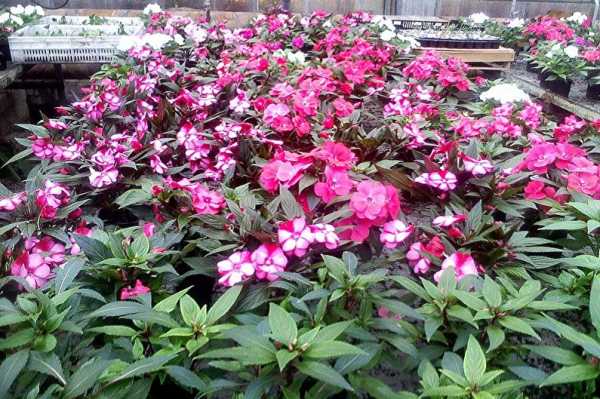

First you need to prepare the soil for the flower bed. Balsam grows on neutral, fertile, loose, light soil. The soil must pass water well. On clay, acidic and heavy soil, balsam will quickly wither. For Vanka Wet, soil is suitable, consisting of garden, leaf, turf soil, mixed with peat, sand and humus in equal amounts.
Weeding
A flower bed must be constantly looked after. Remove grown weeds, loosen the ground, break up the soil crust. You can mulch the ground with sawdust. Weeds will not be able to break through from under the layer of mulch.
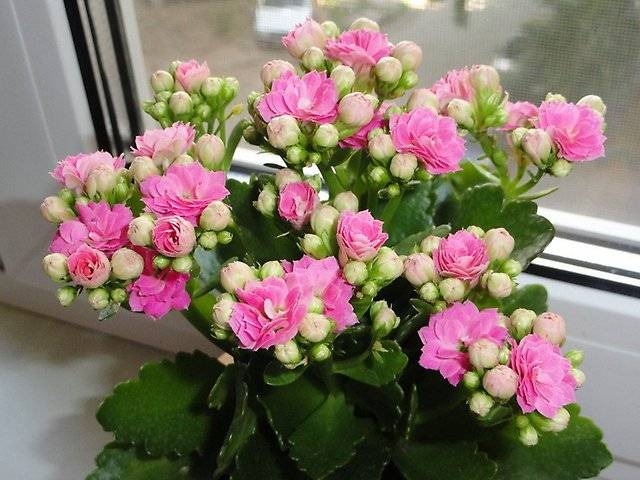

Top dressing
Impossible to feed once every 2 weeks. At the very beginning of development, nitrogen fertilizers are applied to the soil. During the flowering period, the soil is fed with potassium and phosphorus additives. For balsam, complex fertilizers for flowering plants or feeding for geraniums are suitable. For 1 square meter of the plot, you need to dilute 30 grams of fertilizer in 10 liters of water.
Watering
Roly Wet needs to be watered regularly. Do not allow the soil to dry out. With insufficient watering, the balsam withers quickly. However, it is also not recommended to flood a flower bed. In highly moist soil, the plant will begin to rot.
It is advisable to spray the leaves of Impatiens with cold water. Thus, you can protect the bushes from spider mites and aphids.
Illumination
Vanka Wet prefers open, sunny places. It is desirable that the plant is in partial shade in the midday heat. Balsam blooms beautifully under trees with a sparse crown or on the northwest (northeast) side of the house. Balsam has very fragile stems that break in a strong gust of wind. It is better to plant the plant in places protected from drafts and wind.
Varieties and varieties with photos
Balsam has about 400 varieties. The following varieties are most often grown indoors:
- Holst;
- sultan;
- Waller;
- New Guinean.
Inflorescences are painted in a variety of shades: white, scarlet, pink, burgundy, etc. In most varieties, the petals are painted in two colors.
Dwarf
The most popular dwarf varieties are Waller's balsam and Exotic. The first species grows up to 30 cm, has bare, branched shoots, which are attached with long petioles. The inflorescences are large, separate, have a varied color and double petals.
Exotic grows no higher than 20 cm. It is planted on terraces and balconies, choosing the northern side. The plant is unpretentious to grow, it blooms actively even with minimal maintenance. Flowers reach 4 cm in diameter, have lanceolate leaves. The buds are colored lilac or pinkish.
Medium-sized
This subgroup includes the Niamey variety, the bushes of which grow up to 1 m in height. The bush has branched shoots and elongated leaves, tightly attached to the stem. The buds on the pedicels fold into leaf axils, painted in a scarlet shade with orange spots.
Safari is another representative of medium-sized balsams. It blooms during the warm period and has white flowers up to 4 cm in diameter.The flower is used to decorate balconies, kept in flowerpots in the garden. It blooms well both in pots and in flower beds, as its root system is moderately growing.
Tall
This subspecies includes the Peters and Carmelita varieties. Peters' balsam grows up to 1 m in height, resembles a bush, has pubescent shoots. The ground part is colored bronze, and the inflorescences are scarlet. It has high pedicels.
Carmelita grows up to 70 cm, has the shape of a pyramid. The plant loves warmth and moisture, has fleshy stems that can break at the nodes. When blooming, purple and white buds are formed.
The Carmelita variety does not tolerate cold, therefore it withers at the slightest temperature fluctuation.
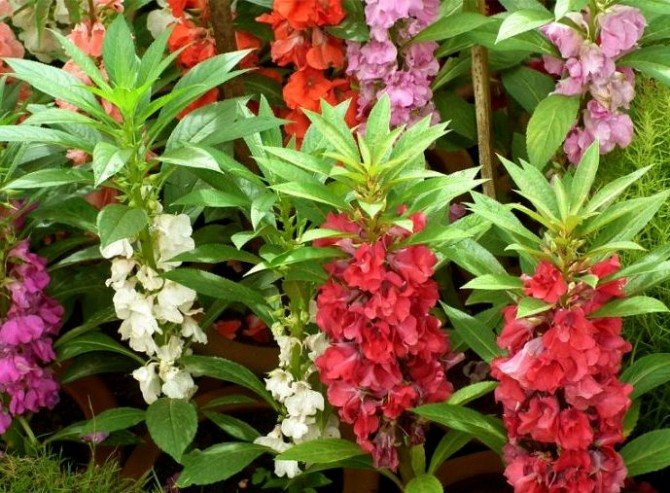

Tall
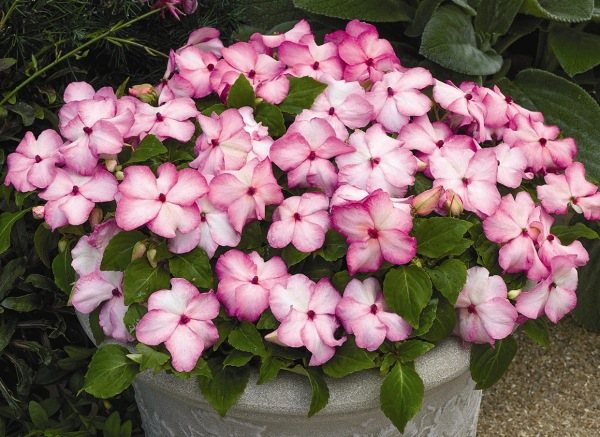

Dwarf


Medium-sized
Camelliaceae
The Camellia variety has large double buds, grows up to 50 cm. It is thermophilic, does not tolerate even light frosts. Camellia is planted on lawns to provide it with maximum sun exposure. You can plant a culture in a slightly shaded place, this will not affect the condition of the flower. The plant loves fertile soil and regular watering, but do not overmoisten it.
Carnation
This subspecies includes the variety Strawberry with cream. This variety is planted on balconies and terraces. The plant loves warmth, so for the winter it must be brought into the house if you are growing balsam in the yard. The branchy bush blooms throughout the summer.
Rosy
From the group of pink balsams, it is worth describing the Eurasia variety. The plant has spherical bushes, the diameter of which reaches 15 cm. Large buds are 6 cm in diameter, painted in cream or pink shades. This variety does not like shade, it grows well in sunlit glades, reacts poorly to waterlogging.
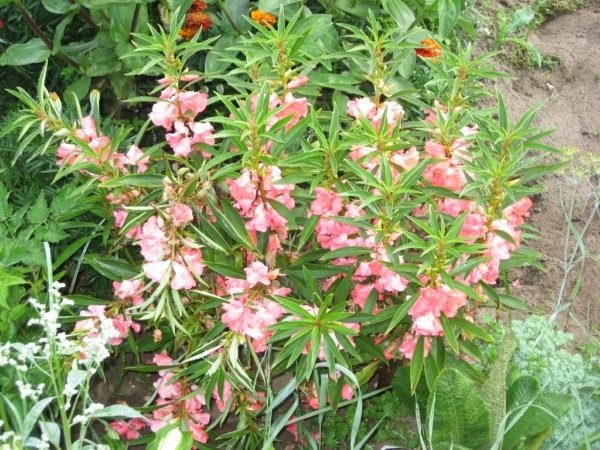

Camelliaceae
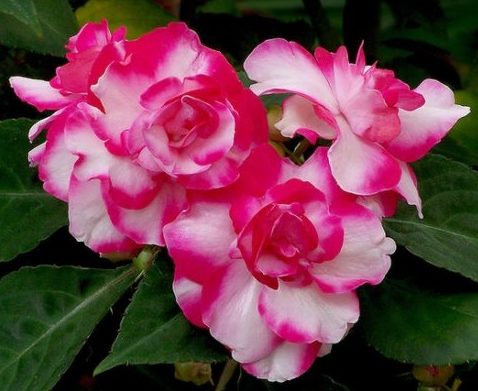

Carnation
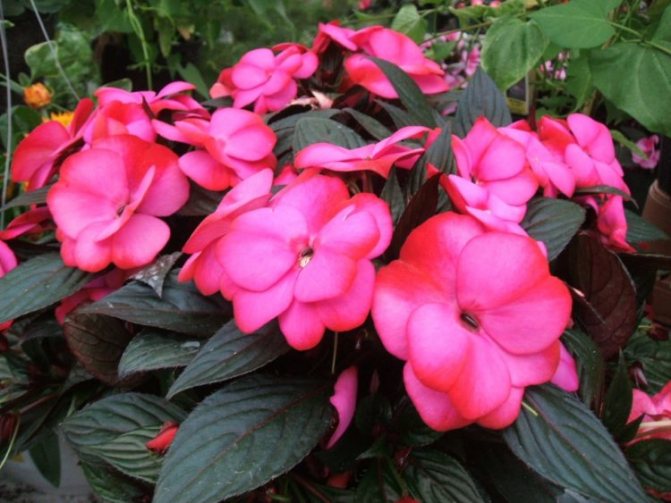

Rosy
Features of indoor growing in a pot
Balsam feels great on the windowsill. True, in the summer, in the heat, the plant needs to be covered from the scorching sun's rays. In the autumn-winter period of Impatient, it is necessary to provide additional lighting, because this perennial has almost no dormant period.
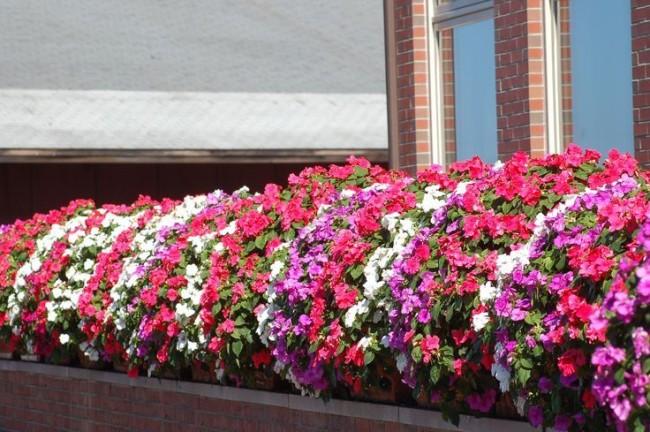

In summer, the temperature of the content can be 20-25 degrees, in winter - 15-18 degrees of heat. The balsam pot is first chosen close, with a drainage hole at the bottom. Roly Wet will bloom after the roots completely fill the space inside the pot. As the root system grows, Touchy is transplanted into a more spacious container.
Soil and watering
For indoor Impatiens, light, slightly acidic or neutral soil is suitable. The composition of the soil should include garden or leaf (sod) soil, sand, peat, perlite. Drainage from expanded clay or stones is laid at the bottom of the pot.
The plant is watered regularly, the leaves are watered every other day. In summer, it is advisable to take pots with flowers to the balcony.
If Vanka Wet becomes too hot, he may wither or discard flowers and buds. In summer, the plants are irrigated in the evening; in the sun, the leaves can become covered with burn marks due to the remaining droplets of water. Once a month, together with water, complex fertilizers for flowering plants are applied to the ground.
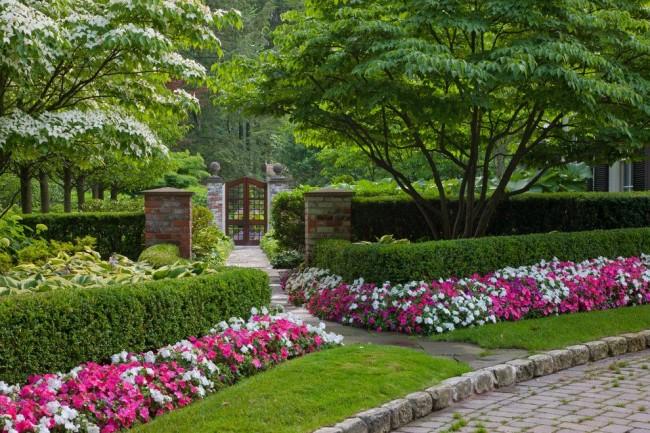

Diseases and pests
Vanka Wet can get sick if he is not properly looked after, rarely watered, or, conversely, the ground is heavily flooded with water. The plant weakens immunity with a lack of nutrients in the soil. Balsam, with improper care, affects a fungal infection. It is in the soil, and then through the roots and stems it passes to the leaves and flowers. The leaves are covered with yellow, brownish, grayish spots, turn yellow and dry out.
Spraying with Fitosporin saves from fungal infection.
The most dangerous pest of indoor balsam is the spider mite. This tiny soft-bodied red insect winds a cobweb on the leaves of a plant and feeds on its juice. Spraying with cold water and an insecticide solution (Akarin, Agravertin, Kleschevit) is saved from the tick.Yellowed or yellow-spotted leaves affected by the tick must be removed.
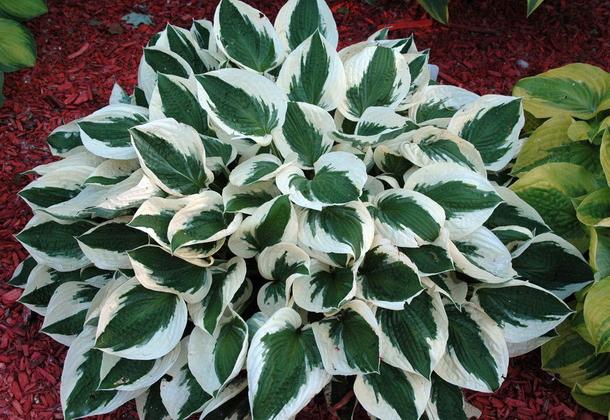

How to water Vanka wet
Balsam is a moisture-loving plant, therefore, when caring for it in the summer, abundant watering is required, but without stagnant water, its excess must be drained from the pan.
In winter, Vanka is watered wet as the upper layer of the substrate dries. The water should be warm and soft. It is recommended to pour it along the edges of the container so that it does not touch the plant itself and its root collar; you can also water it into the pan.
In between waterings, you can loosen the soil to a depth of one centimeter.
Popular species and varieties
Most of the varieties are obtained on the basis of garden balsam, Waller or Hawker, which became the progenitor of the famous New Guinea hybrids. Plants differ in stem shape, height, structure and color of flowers.
Hawker's Impatiens hawkeri
The plant that gave birth to New Guinea hybrids. Leaves - oblong, pointed at the end, shiny. The flowers are large, simple, with a spur, of various shades, with a white core. The height of the balsam is 25-60 centimeters. Stems are erect, long, fleshy.
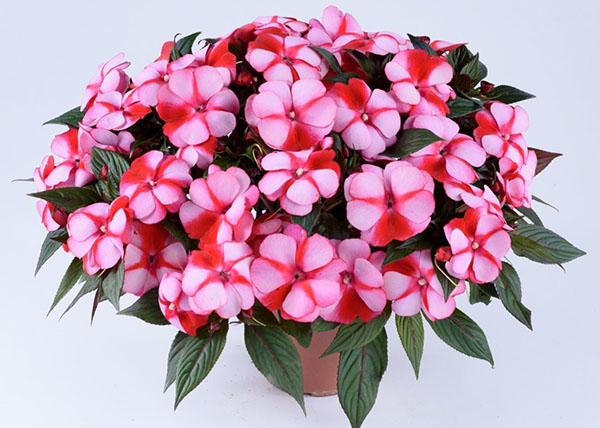

Large-flowered Impatiens hookeriana or Impatiens grandis
The plant is native to Sri Lanka. It has long, fleshy stems. Leaves - shiny, as if covered with wax, green. Flowers - large, like an orchid, white, pinkish, scarlet.
Creeping Impatiens repine
The plant is used in hanging pots, it has creeping, upward, very fragile reddish shoots that break off easily during strong winds. Leaves are small, shiny, bronze-green. The flowers are bright, yellow, large, with a spur.
Impatiens walleriana or Impatiens Waller
A perennial plant often grown as a garden annual. Waller's balsam is a low, strongly branched spherical bush. Flowers can be simple or double, of various colors, located at the top of lush green foliage.


Forest
An annual, herbaceous, poisonous plant. It grows one meter in height. Stem - erect, covered with leaves, can branch. The flowers are like a shoe. They can be pale pink or lilac.
New Guinea hybrids and a simple reason for their rise in popularity
Among all varieties, groups of varieties and even species of balsams (Impatiens), the so-called hybrid varieties of the Nuova Guinea group or New Guinea hybrids (often labeled as New Guinea Impatiens) are today considered the best, although some time ago these plants were considered one of the most capricious and extremely "Western".
The change in status and the rise in popularity of the touchy New Guinean is simply explained: these plants boast a unique ability to bloom all year round. And although in regions with harsh winters they are grown only as seasonal plants in the garden, they cannot be found equal in room culture. The unique flowering time can be appreciated even in the middle lane.
The two main traits of New Guinea hybrids are meatiness and power. They have strong shoots, very densely spaced bright dark green leaves and pretty bright asymmetrical flowers, as if evenly scattered throughout the bush. The beauty of both greenery and flowering distinguishes them from among more than half a thousand species and many thousands of varieties of balsams. And it seems inappropriate to add folk nicknames to this plant - a light, Vanka is wet, touchy. Although the main feature of balsams is the scattering of seeds, the cracking of the capsule at the slightest touch is also preserved by the New Guineans.
New Guinea hybrids first appeared on the flower market in 1972, and the group of these hybrids can be called relatively young. It is believed that they were bred by crossing the Indonesian touch-me-not Hawker with other species.These plants up to 20-30 cm in height can be considered both indoor and garden varieties, but they fully show their talents in the premises. In fact, these are versatile varieties that you can use as you see fit. They have very compact, dense bushes and much stronger shoots that are more resistant to injury than ordinary balsams.
Leaves are dense, broadly lanceolate, sit on short petioles in whorls, decorated with a finely serrated edge, in some varieties they can reach 10 cm in length. On the leaf blades, “sunken” veins are clearly visible. And the flowers are much fleshy, larger, up to 5-8 cm in diameter, with graceful petals and a small colored eye. Flowers bloom in axillary "bunches" or one at a time. In horticultural culture, New Guinea balsams bloom only in spring, but when grown in room culture - all year round.
The colors of the New Guinea hybrids are also appreciated - pure pastel or watercolor shades of color and rare variations of pink shades, fuchsia, candy, salmon, peach, apricot tones. The color of the leaves is also very variable: in addition to an intense dark green, different varieties have brighter variations, and original shades - bronze or with a yellowish enlightenment in the center of the leaf blades.
The variety of New Guinea hybrids allows you to choose both more compact and large plants, which are very different from the more familiar Waller's balsam. Actually, according to their size, they are divided into three groups - compact (up to 20 cm), spreading ampelous and high (up to 60-90 cm) varieties.


New Guinea balsams.
In New Guinea hybrids, not separate varieties are most often distinguished, but whole series of varieties. The best of them are:
- "Macarena" with bronze leaves and orange flowers;
- ‘Jangle Rain’ - balsams with pastel, soft colors and glossy dark leaves;
- ‘Harmony’ - variety series with densely branching compact bushes, bright red, bronze or green foliage and almost round, dense flowers;
- ‘Rainforest Exotic’ - balsams, whose bright "tropical" colors in monochromatic and two-tone variations are perfectly combined with dark leaves;
- "Java" - a series of plants with bright orange-pink-red "acrylic" tones and green or bronze leaves;
- "Mini Gini" is a small-flowered series, in plants of which hundreds of small flowers are strewn with dark bushes;
- "Divaro" - a series of compact densely branched balsamines with bright green leaves and medium neat flowers;
- 'Spreading White' - variegated New Guineans with snow-white flowers.
In growing New Guinea balsam hybrids, the most important thing is to choose the right conditions for keeping and choose the plant itself with all attention to the "details". On sale New Guineans can be found mainly in the spring. But many floral balsams are delivered by fall. When buying, the bushes should be carefully examined, noting the slightest signs of damage by diseases or pests: if you miss even a speck, then the plant will not be cured and, most likely, you will just have to throw it away.


Balsam New Guinea.
Planting and care in the open field
Balsam can be planted in front of the windows of your house or in a city flower bed. Seeds for seedlings are preliminarily sown in March. The grown seedlings are transferred to the street at the end of May or at the very beginning of June. Before transplanting, the seedlings are accustomed to outdoor conditions.
The optimum temperature for planting outdoors is 18-20 degrees Celsius.
Landing features
Roly Wet in the garden is grown as an annual plant. Loves non-acidic, light, well-drained soil. It is better to plant balsam in a bright and well protected place from the wind. Before planting, the soil must be fertilized with humus, add a little sand or peat, loosen and moisten well.Seedlings are planted in shallow pits, on the bottom of which a little sand is poured. The distance to the neighboring plant should be 30 centimeters.
Watering and feeding
Balsam will bloom profusely if watered regularly. It is undesirable to fill the soil with water. In swampy ground, Impatiens will begin to rot. Adult plants are watered and irrigated with water every other day. However, in rainy weather, watering is stopped.


During watering, young plants are additionally fed with nitrogen substances. During the flowering period, the land is fertilized with potassium and phosphorus. You can use complex commercial fertilizers for flowering plants. The touchy is fed once a month.
The soil
To choose the soil for a wet indoor flower, you need to make sure that it is with a moderate amount of nutrients. From their overabundance, the flower will be weak. It is important that the soil is loose, for this it is mixed with sand or peat. It should be borne in mind that the plant grows large enough, so you should take care of its stability in soft soil.
It is important to ensure that the soil is moist, without stagnation of water in the sump. Abundant watering is recommended to be combined with spraying.
Reproduction
Impatiens are propagated by seeds or cuttings. Seeds are sown for seedlings in March. At the end of May, the seedlings are transferred to the street. Cuttings from growing balsams can be rooted all summer.
Seeds
Roly Wet can be propagated by seeds. Usually, seeds are sown no earlier than March, when daylight hours become longer. Prepare the substrate before sowing. The soil mixture can be purchased or prepared independently from garden, leafy soil, with the addition of sand, peat. Seeds are sown on moist soil and covered with foil. Shoots appear after 1-2 weeks.
The optimum temperature for germination is 20-25 degrees Celsius.
Cuttings
Balsam can be propagated by cuttings, that is, cuttings in spring, summer and even autumn. The broken off upper branches must be put into water, and after a week they will sprout. Rooting can be done in wet sand or vermiculite. Then the cuttings with roots are transplanted into peat-garden soil.
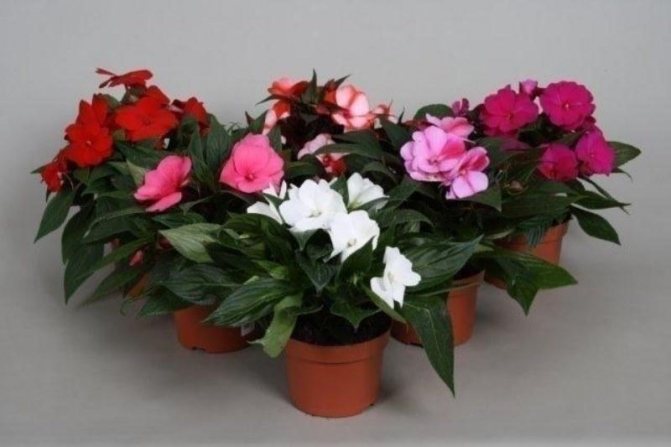

How to get the seeds right
Balsam blooms all summer, and in the fall, juicy fruits appear in the form of a box with seeds. Harvesting seeds is not easy. After all, the boxes explode from a light touch, and the seeds scatter to the sides. You can cover the boxes with a bag or bag and carefully collect the seeds in it.
It is practiced to collect fruits that are not yet fully ripe, which ripen in a dry room for several weeks. In the fall, after the fruits ripen, the annual plant is removed from the flower bed, and the next year new seeds are sown. The seed remains germinating for 3-5 years.
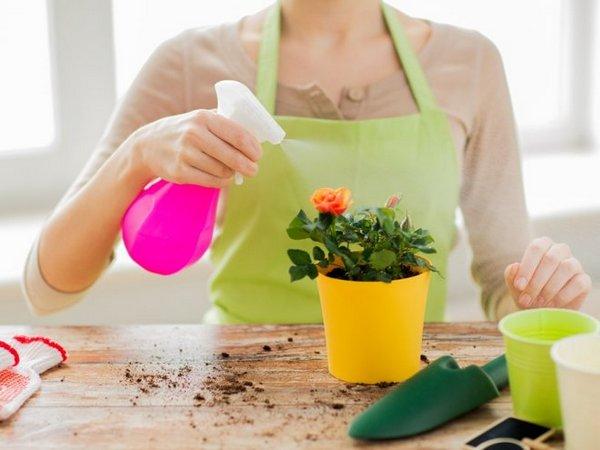

Breeding features
New Guinea Balsam can be propagated in 2 ways:
- Sowing seeds followed by picking. The method is rather painstaking and lengthy, therefore it is used in extreme cases.
- Cuttings. The most optimal method. Shoot tips with 2-3 buds are used as cuttings. The lower leaves are removed, planted in a damp substrate and sheltered. Further care - watering, airing the greenhouse and maintaining the temperature +23 .. + 25 ° С.
It will not be difficult to get a new copy of balsam.
Important! To accelerate the survival rate, cuttings can be treated with a growth stimulant before planting.
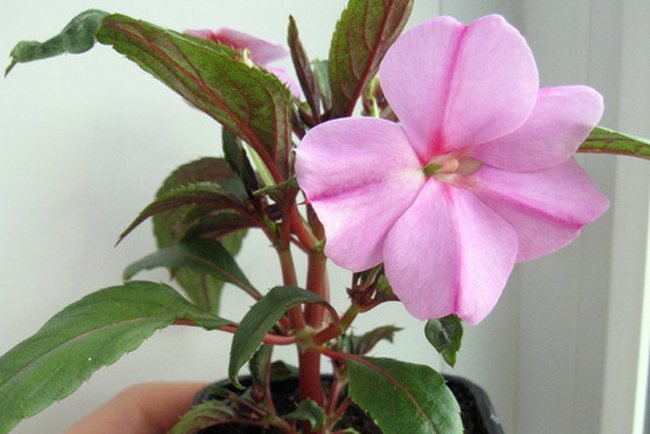

Soon the cuttings will take root and bloom
Seedling growing
Balsam is a thermophilic plant with a long growing season. When the temperature drops to 5 degrees Celsius, it may die. To get a flowering bush in June, in March you need to sow seeds for seedlings.
Disinfection
Before sowing seeds, you need to prepare the soil. You can buy ready-made soil mixture based on peat. You can prepare the substrate yourself.To do this, you need to take in equal proportions garden, turf or leafy soil, peat, sand. It is advisable to disinfect the substrate with boiling water, a solution of potassium permanganate or Fitosporin.
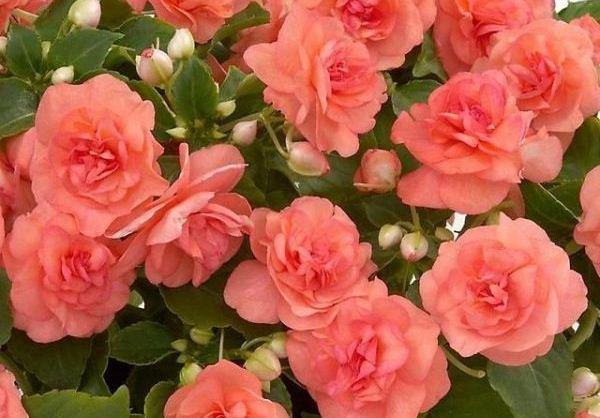

Landing scheme
Balsam seeds are sown in boxes filled with substrate, at a distance of 1 centimeter from each other. Previously, the earth is loosened and moistened. From above, the seeds are lightly sprinkled with sand and sprinkled with water. When the seedlings germinate, they will need to be dived and planted in separate containers.
Film or glass
Seeds sown in the ground are irrigated with water and covered with transparent glass or foil. Every day the glass is raised, the ground is lightly irrigated with water. When shoots appear, the film is removed.
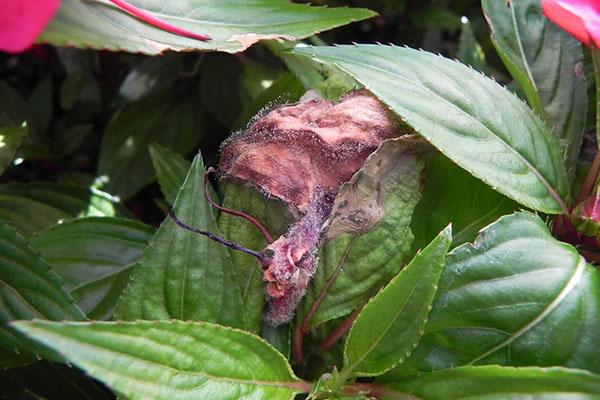

Landing and aftercare
At the end of May, the grown seedlings are transferred to the street. Plants are carefully planted together with an earthen lump in the dug holes. In summer, Touchy must be regularly watered, weeds removed from the flower bed and fed with complex fertilizers once a month.
Transplantation and reproduction of a flower Vanka wet
The twig grows quickly because it has a powerful rhizome. It needs to be transplanted once a year, this procedure should be performed in the spring, before pruning. Plants grow quickly, so they need to be replaced with new ones two years after planting.
Choosing the right pot and soil
The culture blooms profusely only if the roots are firmly fixed in the soil. The container for planting must be selected in such a way that the distance from the stem to the sides is about 7 cm. The light feels great in deep pots. The growing soil must be nutritious. Experts recommend using a mixture of peat, sand and leafy soil.
Step-by-step transplant process
To transplant the plant, the bush must be removed from the old container, the rhizome must be cleaned from the ground and the damaged fragments, if any, must be removed. Fill the pot with drainage and fresh soil. Make a depression, pour water over it. Gently submerge the plant inside, sprinkle with earth on all sides to fix the bush. In this case, it is not worth deepening the trunk, so as not to damage the rhizome. Water the flower again.
Seed propagation
To sow balsam seeds, prepare a substrate of peat and sand. Sow seeds and cover with plastic. Sprouts need to be protected from bright sunlight, spray the soil with a spray bottle every few days. After the first leaves appear, the sprouts are transplanted into separate pots.
Propagation by cuttings
Cut off the top of the stem and trim off the bottom leaves. The cuttings should be planted in small pots filled with sand and peat. It is necessary to keep the pots in the greenhouse, not allowing the earth to dry out. In a few days, the sprouts will take root. You need to accustom the plant to open ground a couple of weeks after planting. A month later, the flower is planted in a pot, where it will grow on a permanent basis.


The culture can be propagated by cuttings
Care features
Vanka Wet is a non-capricious plant. It does not require any special care, only a minimum of attention. The main thing is to ensure Impatient regular watering and timely fertilization.
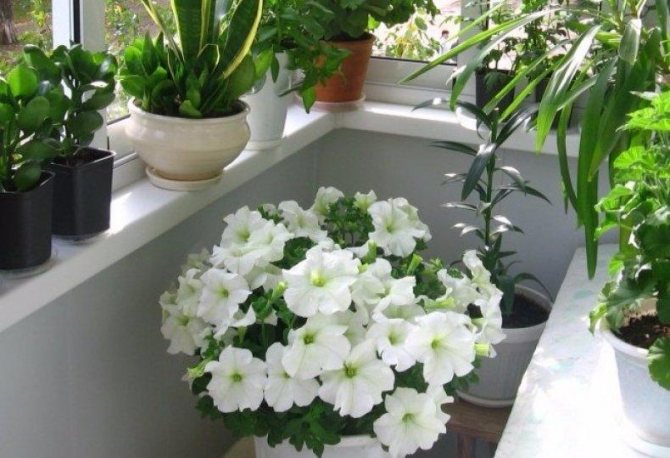

Watering
You need to water the Touchy one regularly, make sure that the earth does not dry out. Balsam instantly reacts to a lack of moisture - its leaves curl, flowers droop. With insufficient watering, the plant can shed flowers and buds.
Spraying
It is advisable to irrigate balsam every other day with cold water. This procedure will save the plant from the spider mite and saturate the touchy with moisture.
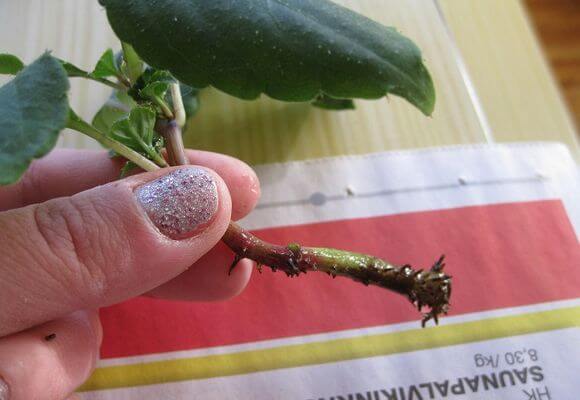

Pinching and trimming
It is necessary not only to look after balsam, but also to pinch it correctly. When the plant grows a little, it is advisable to shorten its top. The balsam will no longer stretch upward, but will begin to form side shoots. The plant will take the form of a spherical, compact bush.True, for this you need to constantly cut off the stems that are too elongated.
Top dressing
For abundant flowering, Impatient needs to be fed 1-2 times a month with complex fertilizers for flowering plants.
It should be remembered that with an excess of nitrogen supplements, the plant will receive lush greenery, and flowering may not come.
Hardening
Usually Impatient, sown on seedlings, is hardened before being transplanted into the street. The room where the seedlings grow is regularly ventilated. In May, in warm weather, boxes with seedlings are taken out into the sunlight for several hours.
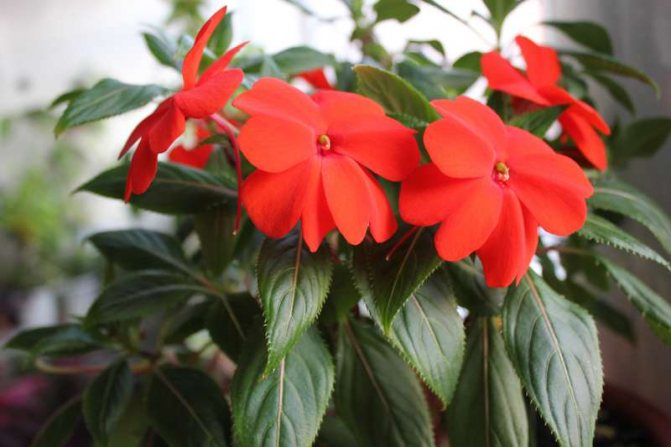

Wintering
In the fall, the yellowed and fading garden balsam is cut off, the roots are dug up and removed from the flower bed. Save the bush in winter will not work. With the onset of frost, he will quickly die. The next season, a new plant is sown.
Pruning
Balsam should be pruned in the spring or early summer so that the plant takes the form of a compact, low bush. Usually at the stem, 30-40 centimeters long, pinch the top. Balsamin begins to actively form lateral shoots.
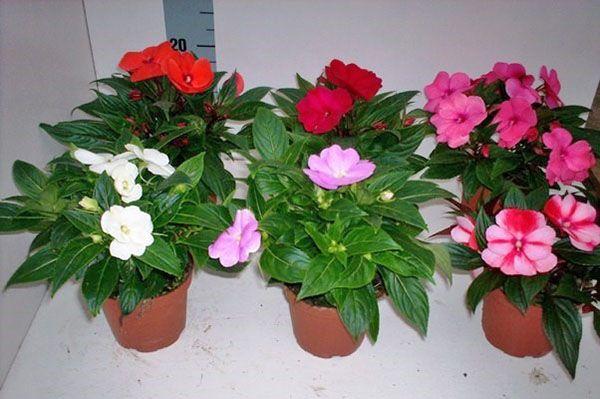

General rules for caring for Balsamin
All types of Balsam have common characteristics and needs. It will be easier for you to care for the plant if you remember them.
- Abundant watering. It is better to pour the substrate than to forget to water.
- Fresh air. They adore it, but cannot stand drafts. When airing the room in the winter, do not forget to set the pot aside from the air currents.
- They bloom better in small pots.
- Easily propagated by cuttings and seeds.
- They love light and warmth.
- They grow well on the windowsill, only in the hot midday time they need to be shaded, and in the winter months - move the pot away from the glass and closer to the edge of the window sill, where you can feel the heat from the battery.
- For winter maintenance, you need a bright room with a temperature of +15 degrees and moderate moisture.
- In summer, balsams can be planted in the ground, and in autumn they can be returned to an apartment or house. In the garden for the summer, they can be planted in the shade of trees.
With proper care, the Spark will continuously delight you with its flowering. Now about everything in order.
Location in the apartment and lighting
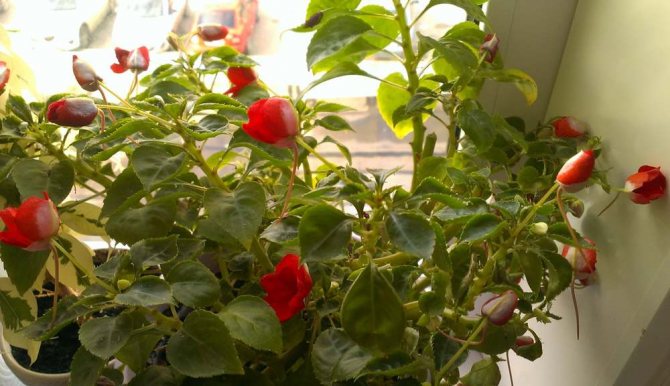

The best place for Balzamin in the apartment is the sill of the south window. There is a place for a photophilous flower. Only young specimens at noon should be covered with a light curtain or blinds so that the sun does not inadvertently burn the delicate leaves through the window glass. If possible, find a place for them on the east or west windowsills. This refers to the summer season, and during the rest of the year you do not need to protect the plant from the sun. On the contrary, if the flower stood somewhere to the side of the windowsill or on the other side of the apartment, transfer it to the south window.
In a dark place, the Fire will not bloom at all. If the pot with a flower is incorrectly positioned, the plant will begin to stretch upward, the stem will become bare, the lower leaves will fall off. Such a Fire will bloom rarely and reluctantly, only at the very top of the head. If you guess the location of the flower in your house, your Balsam will almost certainly bloom from early spring to late autumn, it will only have a short rest in winter, so that with the beginning of spring it will again delight you with bright flowers.
It may be interesting: Oleander - rules for caring for a poisonous flower
In summer, it is advisable to take home Balsam out to the terrace, balcony or gazebo, in a place where there is a lot of light and fresh air, but rain and wind will not be able to reach and break it.
Watering
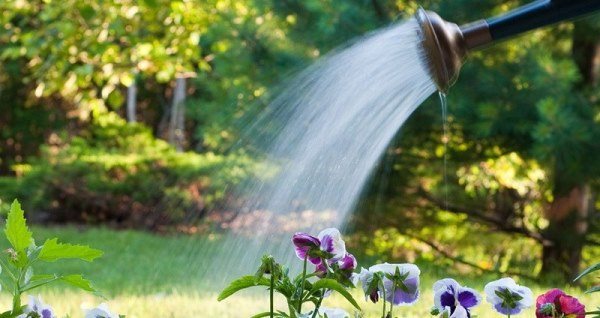

It is equally important for the flowering of Balsam that the soil substrate is kept moist. A bottle with water that has settled during the day should always be ready. In summer, the flower is watered more often, in winter, watering is reduced by 1/3. But without watering Vanka, wet, will not last long. Water it as soon as the topsoil dries to a depth of 1 cm.In hot summer it will be every other day or even every day, and in winter - 2 times a week. Use only soft, well-separated or filtered water, without impurities. If a white coating appears on the surface of the substrate, it means that the water for irrigation is too hard, and alkalization of the soil has begun. Remove the top layer of soil, and pour a fresh batch of substrate into the pot.
Pouring a flower or leaving it in a full pan of water is also not worth it. Especially at low temperatures and low light. Water frequently, but in moderation. Drain excess water from the pan. Do not provoke root rot. Check for drainage holes and drainage in your pot. The root system will get sick - the flower will die. If you water your Balsam correctly, then after each watering in the summer, small droplets of moisture will appear on its leaves, which, after a while, become sugar-coated.
Vanka loves wet, so that after watering the soil in the pot is loosened - this will increase the access of oxygen to the roots of the plant. And yet - it is advisable to pour water in a thin stream along the edge of the pot, so as not to fall on the root collar.
If you notice that the leaves are covered with dust, gently rinse them under running water at room temperature. Otherwise, the flower will not have enough light to produce chlorophyll.
Temperature
The fire loves warmth. A comfortable temperature in the summer should be from 20 to 28 degrees, and in winter in the room where you put the pot for winter rest, keep the temperature at least 16 degrees, since Balsam can hardly stand the cold.
Humidity
Balsam is not picky about increasing the humidity in the room. It's another matter if the room is hot, and the leaves quickly began to lose moisture and dry. Try in all possible ways to maintain the humidity in the room with the flower within 40 - 60%. Place containers with water for evaporation next to the pot, turn on household humidifiers or split systems, cover hot batteries with wet towels in winter, spray the air space with a spray bottle. It is not advisable to spray a flowering plant so as not to damage the buds and spoil the appearance of the flower.
Land
Light but nutritious soil with good air permeability is suitable for Balsamin. Any universal soil from a specialized store, intended for flowering indoor plants, will do. It is also easy to prepare the ground for Balzamin on your own. Take 2 parts of turf, leafy soil, humus and sand. Add 1 part peat. Mix everything well. Steam or freeze this mixture to kill any infection and possible parasites.
Pot
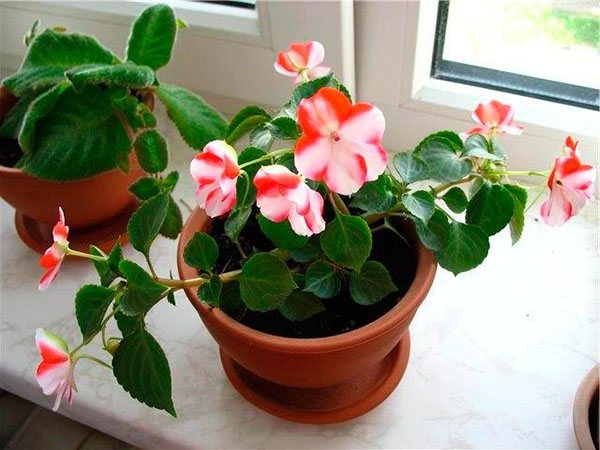

The size of the pot is important for growing balsam. He loves a small flower pot, in which the root system has braided the whole lump - this is an indispensable condition for the abundant flowering of the plant. If you plant the Fire in a spacious pot (which turned out to be at home), then he will spend all his energy on building up the root system. This is how nature has laid it down - the roots of Balzamin must completely braid the lump of soil, only then will it be able to grow and form buds. That is, in a large pot you will wait longer for flowering. In addition, excess soil with frequent watering will sour, which will lead to root disease.
In addition to size, drainage holes at the bottom of the pot and the drainage itself are important, into which, in addition to expanded clay or pebbles, pieces of charcoal or activated carbon should be added to prevent diseases. At the end of the kit, you should purchase a deep tray so that excess water from it does not pour out onto the windowsill.
Top dressing
Balzamin should be fed from April to October twice a month. Fertilizers are used special, for flowering indoor plants, which are dominated by phosphorus and potassium.Nitrogen fertilizers are applied carefully, preferably at the beginning of spring, as they stimulate the growth of the green mass of the plant. Excess nitrogen can harm future blooms. Doses of top dressing are taken according to the instructions or half as much - depending on how long ago you changed the substrate in the pot.
It may be interesting: Home (indoor) geranium or pelargonium - home care
Transfer


Balsam is a perennial flowering plant. Over time, the nutritional value of the soil is lost, the shoots stretch out, the leaves fall off, the appearance of the flower deteriorates. We recommend replanting young specimens of Balsamin in a new pot every year. Choose the size so that the root system of the flower fits into it completely, plus a little fresh soil. Remove extended and excess shoots.
Carry out the transplant using the transshipment method, carefully, since all parts of the plant are very fragile. Water the substrate. Add more soil if necessary. When the Fire adapts in a new pot and wraps around the whole clod of earth, then it will bloom.
If you only have a large pot, you can plant two or three balsam cuttings with different flowers at a distance of 5 - 7 cm in it at once. They will get along well together, and you will get a magnificent multi-colored bush.
Adult specimens of Balzamin, which have lost their attractiveness, are advised to rejuvenate by rooting cuttings from the tops of the shoots.
Pruning
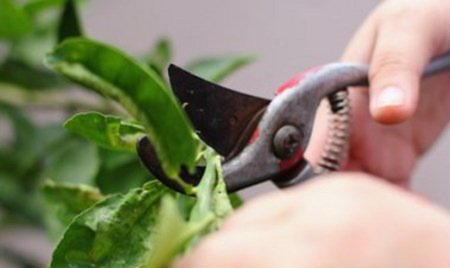

Balsam is pruned regularly throughout its life. If you are growing a Spark from a seed, then, as soon as the seven-leaf leaves appear, pinch the top of the central shoot. Then the side shoots will begin to develop, and the balsam will form a beautiful bush.
If you want to form a tree-like flower, wait until the stem of the young plant stiffens. Then carefully cut off all the lower leaves, and pinch the main shoot. Sprinkle the cuts with crushed coal. Form side shoots over time. After pruning, feed the plant with fertilizers (urea, vermicompost).
At the beginning of spring of any age, Balsam should be cut off. Annual increments should be halved. By the way, the crown of the Ogonyok should be formed throughout the entire period of its growing season, namely, when the young shoots reach the desired length, the upper growth point should be pinched. This stimulates the formation of new lateral stems, which will soon have bright buds and beautiful flowers.
Balzamin's appearance is monitored all year round. Overgrown and weakened shoots, wilted flowers and leaves are removed, diseased and lost decorative parts of the plant are cut off. It is necessary to maintain the decorative appearance of the flower constantly. In order for Balsam to have a uniform, beautiful crown, the pot with the plant must be periodically turned, exposing the flower to the sun from different sides. In addition, by constantly looking at the flower, you will not miss the onset of the disease or the attack of parasites.
Dormant period
How to save Balsam until next year? Balzamin does not have a rest period in the usual sense. For several winter months, he is forced to rest from the violent flowering, since there is not enough light for him to fully bloom. At this time, it is necessary to transfer the flower to a cooler room (16 - 18 gr.). Temperature at 10 degrees. is critical for Balzamin.
Watering should be reduced, but just like in summer, it should be watered when the topsoil dries to a depth of 1 cm. It is impossible to overdry the soil, as this can lead to a weakening and delay in flower development. If the room is too dry and hot, you need to spray the air around the flower, not hitting the buds with a jet. It is better not to carry out top dressing.
If you arrange additional artificial lighting for the flower using a phytolamp or fluorescent lamp, then keep other care items necessary for the flower - heat, watering, feeding with liquid fertilizers once a month in a weak concentration. Then the Ogonyok will delight you with its flowering all year round.
Diseases and pests
In rainy and cool weather, balsam growing in a flower bed can get sick.The plant is often affected by fungal infections, due to which its roots rot, the stems darken, the leaves become covered with brown and gray spots, and subsequently wither. Preventive spraying with fungicides (Fundazol) saves from fungi.
Spider mite
The touchy is often attacked by insects, for example, aphids, whiteflies, thrips, ticks. Most often, balsam suffers from a spider mite. It is a small reddish insect that weaves webs and sucks sap from leaves.
Spraying with cold water, soapy water or insecticide treatment (Spark) is saved from the tick.
Viral mosaic
Hard to reach is affected not only by fungi, but also by viruses. The diseased leaves become covered with yellow spots, and then dry up and wither. Protecting balsam from the viral mosaic is not easy. The best preventive measure is proper care and adequate mineral supplementation.
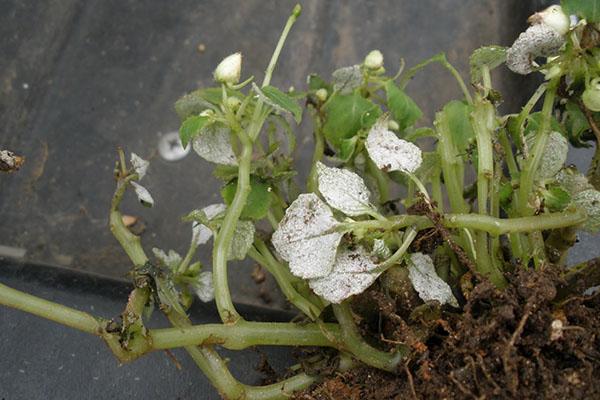

Bronze of leaves
With improper care of balsam, lack of potassium, after strong liming of acidic soils, the leaves can become covered with small dots of dead tissue, acquire a bronze color, become wrinkled, twist downward.
The bronzing of the leaves can be caused by a virus. As a preventive measure, the soil is disinfected with potassium permanganate before planting balsam, a sufficient amount of potassium and phosphorus is introduced.
Ring mosaic
Light round spots appear on the affected leaves of the plant. The disease is caused by a virus. Its vital activity can lead to the death of the plant. Correct care, timely application of top dressing, removal of weeds, spraying of soil and plants with a weak solution of potassium permanganate saves from the virus.
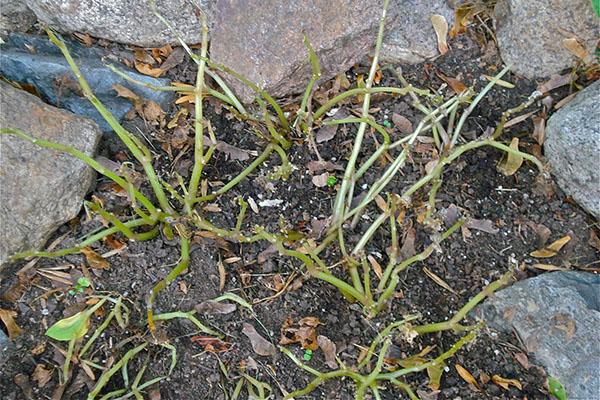

Reproduction of eternal flowers
The most common method is cuttings or seeds. It is better to carry out the procedure in the spring. To rejuvenate the plant, you can use the following method: long, fresh and strong stems are cut. They are placed in water, the time is expected when the cuttings will take root. Then they are planted in place of the old flower. Over the summer, young seedlings grow strongly. If the vanka does not have enough sunlight, then it stretches out and becomes unattractive.
Experts advise to renew evergreen once every 12 months. Often, cuttings placed in water continue to bloom. Several varieties can be planted in one container. Plants nearby get along well, and the decorative effect of such a planting is amazing. Balsam will be interesting not only for beginners, but also for experienced flower growers. Now many new varieties of the flower have been bred. There is a terry and variegated look.
Crocosmia Lucifer: planting and caring for a flower
Ivan easily reproduces not only by cuttings, but also by seeds. They do not have to be obtained at home. Balsam seeds are purchased from a flower shop. For example, lately, the following varieties are known among florists:
- Orange star.
- Peach butterfly.
- Strawberries with cream.
- Cherry miracle.
Growing difficulties
Often wet balsam Vanka is planted on the balcony. This flower will adorn any interior. If the balcony is not glazed and the plant is in the fresh air, then you need to choose a bright, but protected from direct sunlight corner. In this case, the inflorescences are large and rich in color. Although the vanka is considered a flower for beginners, when growing it, there are certain problems:
- If there is a lack of nutrients in the soil, then the stems of the plant become elongated, and the leaves turn pale and shrink.
- The balsam turns yellow, its leaves fall off - this is a sign that the container with the soil has become cramped or the flower does not have enough sunlight.
- Balsam quickly overgrows - this is determined by the rapid elongation of the stems, the roots are exposed, and the plant becomes aesthetically ugly. This usually happens due to high temperatures, over 25 degrees.
In order for the plant to have a beautiful shape and fit the interior, experts recommend updating the balsam in the spring. To do this, cuttings are cut, rooted in water, and then planted in a container.
If rotten roots are noticed in an everflower, which have acquired a brown tint, and at the same time the leaves curl and fall off, this means that the plant is watered too much or it is cold. This kind of nuisance happens to balsam when it grows outdoors. Eternal Blossom does not tolerate rainy, cold nights.
Recommendations for choosing a flowering houseplant
If the grower noticed that the foliage flies, dries and curls, then this means that the plant does not like dry and hot air. This problem often occurs during the winter. In this case, the balsam is removed away from the heating appliances. Such difficulties also appear in hot summer months. To solve the problem, the plant is placed on the floor in the cool part of the room. It is also recommended to spray balsam frequently.
If variegated varieties lack lighting, then they begin to lose color. If the flower has poor flowering, then the reason is insufficient lighting, poor nutrition from the soil, or excess fertilizer. Plants do not like nitrogenous feeding. If the balsam has flown around the inflorescences or flowering has stopped, then the reason is a sharp change in the temperature regime in the room or overdrying of the soil. Too large a container or the wrong time for transplanting negatively affects the health of the flower. The procedure should not be carried out during flowering or picking up buds.
Garden balsam
Indoor plant Vanka wet is often used for landscape decoration and summer cottages. Moreover, it will feel great not only in a container exposed to the air, but also in the open field.
For landscape design, there is also an annual type of flower - garden balsam. He comes from East India, where it grows freely in natural conditions. The plant has an attractive appearance: a straight trunk with lush foliage, decorated with denticles along the edges.
Garden balsam pleases with its flowering for a long time. Moreover, its flowers are both simple and double. In addition, they have a wide range of colors and shades. The plant is planted in places with sufficient light supply. Garden balsam is propagated by seeds.
There are many popular beliefs associated with a house plant. It is believed that Vanka wet has a beneficial effect on creative people. It also has an effect on good mood among family members. If peace reigns in the house, then balsam blooms long and thickly. If there are frequent quarrels in the family, this can negatively affect the plant.
An interesting fact is why the Vanka wet flower received such a name. The fact is that the plant often releases juice, which settles on the stems in the form of droplets. Most likely, it is for this reason that it is believed that balsam in the house can lead family members to alcoholism. Those people who believe in these legends simply do not have a plant. In any case, balsam pleases many people who have this flower on their windowsills.
Watch the video! Roly wet - breeding methods
Unpretentious balsam - Vanka wet is also used in decorative and home gardening. At the same time, plants of familiar indoor varieties are often used for landscaping areas and landscape design, planting them in containers or open ground.
Along with the houseplant Vanka wet in landscape design, an annual form is also used, which is called "garden balsam". This plant spread from East India, where it is found in the wild. It has a lush erect bush with juicy fleshy shoots and green toothed leaves.
The plant blooms for a long time and abundantly. The flowers of Vanka wet can be simple or double. They are distinguished by a wide palette of various shades. This thermophilic plant requires a well-lit area. Garden balsam is propagated by seeds.
Often, signs and superstitions are associated with a indoor flower Vanka wet. They say that it has a positive effect on creative people, contributes to the creation of an atmosphere of harmony and harmony in the house. If peace and respect reign in the family, this flower will bloom magnificently and lastingly. Misunderstandings and disagreements between family members, on the contrary, can affect the plant negatively.
Vanka wet got its name because of this feature: often droplets of juice appear on its juicy green stems. Probably for the same reason, the superstition arose that because of the flower, family members may become addicted to alcohol.
How these facts are related to each other is not clear. And, of course, it is everyone's business to believe in such signs or ignore them. But in favorable conditions and a sincere home atmosphere, the balsam will bloom and prettier day by day, delighting households with the bright lights of their flowers.
Among the masterpieces of indoor plants "Vanka wet" takes a special place. He has been living in our houses for a long time. "Vanka - a wet flower" is a purely Russian name for a flower, in England it is called "Zealous Lisa", and the botanical name is indoor balsam.
This houseplant gained popularity due to its decorativeness and unpretentiousness. It is not difficult to take care of it, and the result obtained in the form of abundant and very bright flowering will make it possible to decorate any interior. Uncomplicated inflorescences, reminiscent of roses, almost cover its foliage with their petals, forming a colorful bouquet with a light aroma.
Balsam flowers have a color from bright red to pale pink, there are also orange-yellow, orange-red, pale pink with darker, lilac-lilac flower centers. Due to the shape of the inflorescences, this flower is often called indoor roses.


